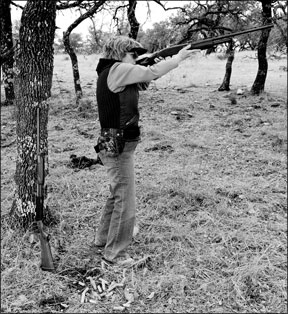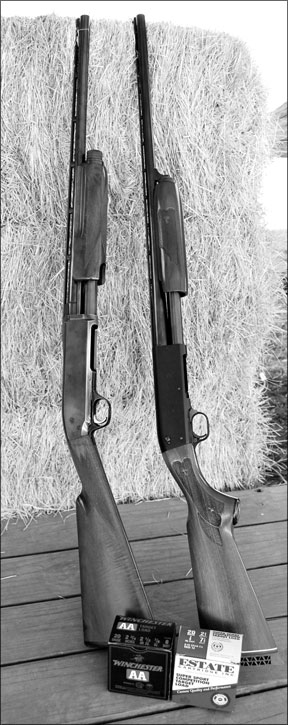The quest for a used shotgun that will meet the all-round needs of a hunter and target shooter can often require some lengthy rack time looking over a number of selections. Toss in some specific needs and that search becomes even more complicated. We set out with a goal of finding a small-gauge shotgun that had to meet a number of requirements:
-A length of pull suitable for a youngster or small-stature shooter.
-Reduced recoil to keep a novice shooter from experiencing shell shock and possibly giving up the sport.
-An action that could be worked by either a right-handed or left-handed shooter.
-Simple function and a shell ejection system that did not sling spent shells all over the countryside.

What we finally brought to the test table were two pump-action shotguns that have been providing hunters across the country with a quality field gun for quite some time. Our pair of pumps that met our special needs were the Browning BPS Special Steel Field Model and the Ithaca Ultra Featherlight Model 37.
Both of the shotguns featured short barrels and were more suited to field use than clay target busting; and both offered qualities that have built a good fan base for the veteran firearms.
One of the key features of both shotguns is the bottom ejection system that helps a shooter retrieve fired hulls by keeping them close to your feet, rather than flinging them into the next county. This feature is particularly welcomed by dove hunters who don’t want to irritate landowners by leaving spent shells all over the county or by those shooters who like to retrieve their hulls for reloading.
The bottom-ejection system, which worked well with both of our test shotguns, also eliminates the problem of spent shells flying across the field of vision of left-handed shooters, which can happen with a right-hand port of a standard pump shotgun.
While prices and conditions of representative models of the two shotguns might vary by quite a stretch depending upon where the purchaser picks up his prize, we were pleased to find both of our models carried price tags of around $400. As a beginner shooting tool or a reliable back-up shotgun, any quality scattergun costing about four Benjamin Franklins is normally a bargain. As our testing was limited by the parameters of our specific needs, we decided to focus on some standard 2 3/4-inch field and target loads for our test ammunition. The loads included Winchester Super Speed Xtra Game Loads with 2.5 dram equivalent of powder and 7/8 ounces of No. 8 shot with a muzzle velocity of 1,275 fps; Estate Super Sport Competition Target Loads packing 2.5 dram equivalent of powder and 7/8 ounces of No. 7.5 shot with a muzzle velocity of 1,200 fps; and Winchester Super Sport Sporting Clays with 2.5 dram equivalent of powder and 7/8 ounces of No. 7.5 shot with a muzzle velocity of 1,300 fps.

Patterning performance with all the ammunition in each of the shotguns was satisfactory. The loads all produced a 50-50 pattern (50 percent of the shot below and target center and 50 percent below) at 30 yards. That is an ideal pattern for a field gun. Here’s our test report:
Browning BPS Special Steel Field Model Pump 20 Gauge, $370
Slim and trim, with enough weight to help the shotgun glide through targets, the 22-inch barrel Browning was an instant hit with our group. We felt comfortable with the straight grip on the English-style stock, and the finger grooves in the forearm proved to be a natural fit.
The overall length of the Browning was only 42.25 inches, with a drop at the comb of 1.5 inches and a drop at the heel of 2.5 inches. The length of pull was a short 14 inches, but was not uncomfortable for the test team.
We were surprised at the weight of the shotgun, which tipped the scales at exactly 7 pounds. However, the weight actually enhanced the handling ability of the shotgun and also helped reduce recoil. We did not feel that the shotgun was too heavy, even for a youngster just beginning a shooting career.
The action of the Browning was very slick with no hitches when used either by right-handed or left-handed shooters. The safety on the top of the receiver was a definite plus for ease of handling by either hand.
Although the action release is located on the left side of the trigger guard, we had no problems working the release with either hand—another plus for the Browning. Fired shells were ejected with authority and, as noted earlier, did not travel farther than a few feet from where we were standing. We experienced no functioning problems at all with any of the ammunition.
Another pleasing feature of the Browning was the trigger pull, which tipped the scales as just barely 5.5 pounds. A slightly lighter pull would have been appreciated by our team, but we were impressed with the crispness of the touch off.
We liked the screw-in choke feature of the Browning, which provides the shooter with a wider variety of shooting options. Only the Improved Cylinder choke came with the used shotgun, but other chokes are easily available for purchase at most sporting-goods outlets.
As a side note, several members of our team pointed out that the short overall length of the shotgun and its quick handling ability would make the Browning a decent home defense shotgun.
It should also be noted that the suggested manufacturer’s retail price for a new model of the Browning BPS is $529 (BPS Upland Special, catalog number 012216607). We felt the price of our used shotgun was a bargain.
Ithaca Model 37 Ultra Featherlight Pump 20 Gauge, $430
This shotgun model has been around hunting circles for quite some time and has a great number of pump-action fans. Judging from the serial number, our test shotgun was manufactured in the early 1980s, and the only non-standard feature was the installation of a new recoil pad.
Ithaca has gone through several ownership changes since the Model 37 was introduced to the shooting world in 1937. The most recent ownership team has announced plans to reintroduce the shotgun sometime in 2008 with a price tag of $959.
Our used model featured a 25-inch barrel and had an overall length of 44.5 inches. The drop at the comb was 1.75 inches and the drop at the heel was 2.25 inches. The length of pull (with the new recoil pad) was 14.25 inches, which we still considered short enough to be handled by a youngster or shooter of smaller stature.
The barrel was fixed choke (Modified) topped with a red-bead front sight. Nearly 2 pounds lighter than the Browning, the Ithaca was very quick handling, and recoil was slightly heavier than the 7-pound BPS. We would recommend sticking to light 7/8-ounce loads for young or small shooters.
A major downside to the Ithaca was the trigger pull weight of 8.5 pounds. A little gunsmith work would reduce the pull to a more acceptable weight, and if we were going to add the Ithaca to our shotgun collection, this would be a necessary step. The action of the Ithaca was not quite as smooth as that of the Browning. Several times the shotgun failed to feed a round into the chamber when we attempted a fast pair of doubles.
The slide-glide factor of the Ithaca seemed to have a few hitches and catches that required a slower pump action than the Browning to ensure a smooth function of the pump. While the bottom ejection system worked well with both right-handed and left-handed shooters on our team, the safety and the action release on the right side of the trigger guard were cumbersome for our lefties.
As noted earlier, there were no functioning problems with any of the ammunition and recoil, while slightly more than with the Browning, was still in the acceptable range for youngsters, in our view.
The current iteration of the Ithaca Gun Company lists the Model 37 as its only shotgun offering. For those of you who might consider buying a new Model 37 and wonder how it compares to our test gun, both units have machined-steel or aluminum receivers. But Ithaca Gun now uses CNC machining to produce better uniformity and parts interchangeability. Also, the new gun lacks soldering and brazing like that on our used 37. In what the company calls the Solderless Barrel System, all peripheral components of the barrel are now held by lugs machined directly out of the parent material of the barrel. Elsewhere, the receiver top is matte-blued to reduce glare, and the receiver’s game-scene engraving has been cleaned up. The buttstocks and fore-ends are now made from fancy black walnut with laser-cut checkering.
0408-Browning-BPS-Special-Steel.pdf





























